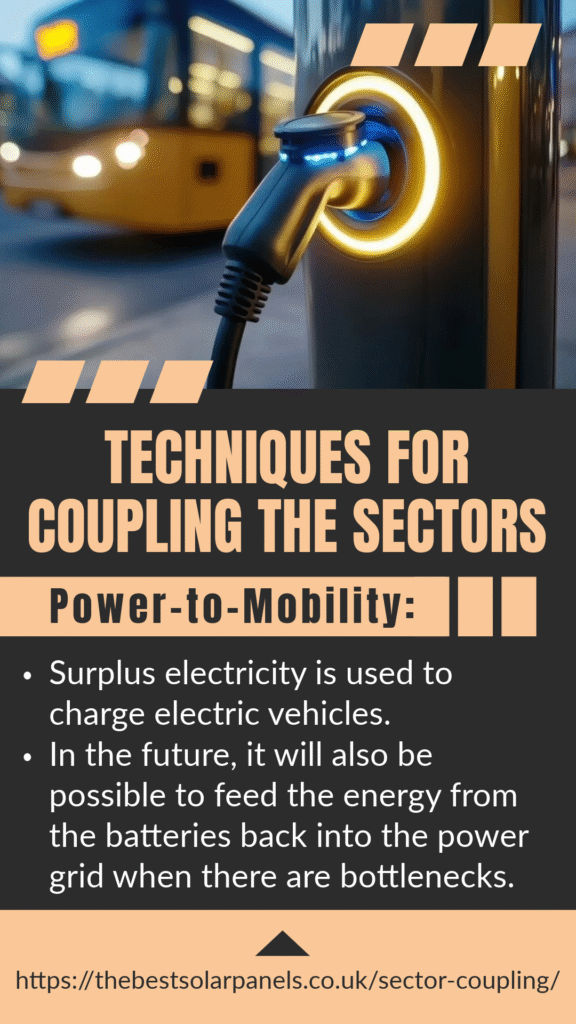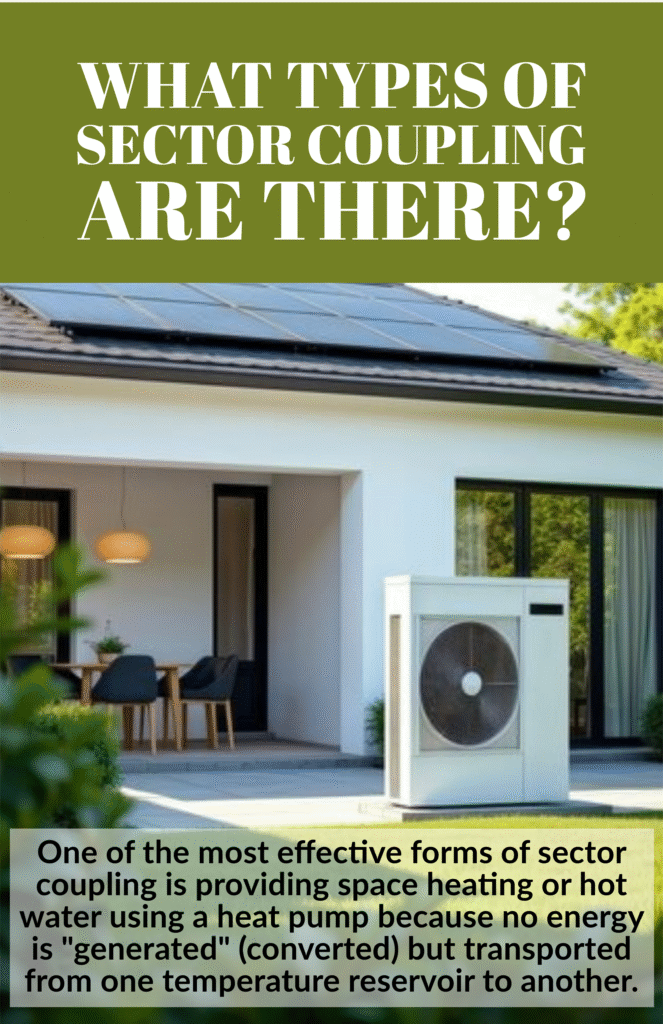People still use large quantities of fossil fuels for heat generation and as fuel in transport. Sector coupling is the technological approach to replacing these energy sources with environmentally friendly electricity. The heating, electricity, and transport sectors must be better interconnected to advance the energy transition. This article explains what this term means and how sector coupling can advance the energy transition.

What is sector coupling?
Sector coupling means:
1) replacing fossil fuels with renewables
2) compensating for renewables’ volatility (fluctuating quantities).
3) comprehensive networking of all sectors of the energy industry.
Sector coupling connects energy systems from different sectors—heat, electricity, and transport. The goal of sector coupling is to reduce CO2 emissions and thus contribute to the energy transition and climate protection. So, the use of renewable energies is at the heart of sector coupling.
In connection with volatility, we can mention that sector coupling is closely linked to the introduction of “smarter” / “more intelligent” electricity grids, since only through constant measurement and control can a balance between consumption and generation be achieved.
Technical systems, infrastructures, and markets should be more closely coordinated to establish a comprehensive, intelligent energy system. The goal is to provide and use renewable energy at the right time and in the right place .
The two most important renewable energy sources in the United Kingdom are wind and solar power. Wind and solar power can be generated easily and inexpensively and transported via existing infrastructure. So, it makes sense to convert the transport and heat generation sectors to green electricity, replacing combustion-based energy generation.
However, wind and solar energy are volatile. In other words, they generate different amounts of electricity at different times. If the energy cannot be used or stored during peak times, it is lost unused. If, on the other hand, too little electricity is produced, the gaps currently have to be filled with conventionally generated electricity. So, we need both short- and long-term electricity storage solutions from renewable energy sources if we are to completely replace fossil fuels.

What is the aim of sector coupling?
Sector coupling is intended to make a decisive contribution to achieving ambitious climate protection goals. This will be achieved through the increased use of renewable electricity to replace fossil fuels in the transport, heating, and industry sectors. Also, the use of efficient technologies is intended to reduce the total amount of energy required. The most important overarching goal is the reduction of greenhouse gases, which are produced by the combustion of coal, natural gas, or oil and drive climate change. Besides, sector coupling is also intended to contribute to the abandonment of nuclear energy.
Techniques for coupling the sectors
To utilize green electricity in other sectors, various technologies are used, collectively known as Power-to-X. What they all have in common is that they convert renewable electricity into other energy sources and/or temporarily store it. There is often some overlap:
Power-to-Gas
Using electricity, hydrogen is produced through electrolysis. The gas can either be used directly or further processed into methane. Methane can be fed into the existing natural gas grid and used in any plant that burns natural gas. Combustion produces approximately the same amount of CO2 as was used in its production. The overall balance is thus balanced. The system is not yet economically viable, but it has significant development potential. Ammonia—a gas produced from hydrogen and atmospheric nitrogen—also offers great potential for energy storage and, for example, as marine fuel.
One of the biggest challenges in power-to-gas technologies is minimizing energy losses, because electricity is not converted 1:1 into another energy source. For example, almost half of the energy is lost during methane production using the power-to-gas process. Added to this are losses during compression or liquefaction for transport.
Power-to-Heat
Electricity can also be converted into heat. A very efficient technology is the heat pump combined with a photovoltaic system. Heating elements, electric boilers, and electrode boilers also belong to the Power-to-Heat category. The latter enable very high heat outputs and can even deliver steam at temperatures of several hundred degrees Celsius for industrial processes.
Power-to-Mobility
Surplus electricity is used to charge electric vehicles. In the future, it will also be possible to feed the energy from the batteries back into the power grid when there are bottlenecks.
Power-to-liquid
This process converts electricity into liquid fuels such as methanol, known as e-fuels. The basis for this is the production of green hydrogen.
Power-to-Chemicals
This technology is also based on the power-to-gas process. Electrolytically generated green hydrogen is used to produce chemical raw materials such as propylene, ethylene, and ammonia.
Energy storage plays a key role in sector coupling: battery, fuel, gas and heat storage systems absorb energy surpluses and make them available for later use.


What types of sector coupling are there?
One of the most effective forms of sector coupling is the provision of space heating or hot water using a heat pump. Since no energy is “generated” (converted) but rather transported from one temperature reservoir to another, the heat pump achieves the seemingly impossible. The energy provided as heat is many times greater than the electrical energy used. Learn more about heat pumps here.
The direct heating of a storage medium by means of an electrical resistance heater (like the heat pump, belongs to the power-to-heat sector coupling) is associated with only low energy losses, but only as much heat energy can be generated as electrical energy was used.
Not All Sector Coupling Is Equally Efficient
The use of solar power for electric vehicles is particularly cost-effective and climate-friendly. The freely accessible and free solar energy is converted into electricity, which is used to charge the electric car’s batteries. It couldn’t be cheaper. Also, the electric motor utilizes the supplied energy much more effectively than a combustion engine: The efficiency rates are over 70 percent compared to approximately 30 percent (figures vary considerably). If the electric car uses electricity from its roof, the overall balance is likely to be significantly better.
While heat pumps and electromobility excel in terms of their efficiency, other forms of sector coupling often have a less convincing overall energy balance. For example, the conversion of electricity into hydrogen, methane ( power-to-gas ), or synthetic fuels ( power-to-liquid, e-fuels) is itself very energy-intensive. Experts estimate the overall efficiency of hydrogen cars at less than 20%—the key reason why it doesn’t make sense to rely on this technology across the board.
There are two main reasons why less efficient forms of sector coupling need not be discarded outright. Firstly, converting electricity into hydrogen, for example, enables simple energy storage and thus opens up a possibility for balancing fluctuations in the supply of renewables. Secondly, this approach allows for applications that require high energy density . For example, hydrogen combustion can generate enough energy to melt steel. This is not possible with a heat pump.


Sector coupling and energy transition
For around 200 years, that is since the beginning of the industrial age, humans have been burning large quantities of fossil fuels. The carbon bound in the Earth’s interior in the form of coal, oil or gas is then released as CO₂. The concentration of the greenhouse gas has demonstrably increased from values between 150 and 300 ppm to well over 400 ppm, and the trend is rising. What may not seem like much at first glance (ppm stands for parts per million) actually has far-reaching effects. Carbon dioxide and other greenhouse gases such as methane and nitrous oxide contribute to the so-called greenhouse gas effect. The higher their concentration in the atmosphere, the more it heats up, because the gases prevent heat from being radiated back into space.
Replacing fossil fuels with electricity
The impacts of a higher global average temperature are now almost impossible to ignore, and the task of reducing greenhouse gas emissions is becoming increasingly urgent. Sector coupling offers a technical possibility to reduce the amount of fossil fuels used for energy production, heat generation, and transport and replace them with renewable energies.
Different successes in the sectors
If we examine the sectors according to their share of greenhouse gas emissions, the energy sector leads the field, followed by the industrial sector and transport. These three sectors are responsible for approximately three-quarters of total emissions; together with the building sector, this figure rises to 90%. So, these sectors offer the greatest potential for savings.
While the energy sector has already achieved significant savings of approximately 40% since 1990 , the transport sector has stagnated – CO₂ emissions have remained virtually unchanged after more than 30 years. Analysts expect this to change, primarily with the help of the transition to electromobility. The contribution of synthetic fuels or hydrogen to the “transportation transition” is currently under discussion. While the potential for private vehicles is likely rather limited, hydrogen-based solutions for heavy machinery, buses, trucks, etc. are conceivable.
Is sector coupling only possible with renewable energies?
In principle, all of the processes mentioned can also be implemented using fossil fuels . Whether the heat pump, the electric car, or the electrolysis of water are powered by green or fossil electricity is technically irrelevant. In other words: Sector coupling also works with electricity that was not generated in an environmentally friendly way.
What remains to be clarified is: Does sector coupling with fossil fuels make sense? We can answer this question with a clear no, with the possible exception of heat pumps. Otherwise, converting electricity into mobility or heat always involves a certain amount of energy loss, a further step that reduces the overall efficiency of the system. This not only equates to economic losses, but also brings no benefits for climate protection. In other words, sector coupling only becomes effective when the electricity used comes from renewable sources.
Another important argument for the use of renewable energies in the context of sector coupling is the close proximity of energy production. If, for example, the electricity comes from one’s own roof, the transport distances and associated losses are very short. To ensure this advantage is truly realized, decentralized energy production is always preferable to large-scale projects with long transport distances.

Sector coupling and PV
Your own rooftop photovoltaic system is the ideal prerequisite for promoting sector integration in your home. With this cost-effective electricity, you can:
- charge the electric car
- heat the apartment (heating water heat pump)
- generate hot water (electric heating element or domestic hot water heat pump)
This not only reduces your energy costs but also avoids significant CO₂ emissions. With rising prices for fossil fuels and carbon dioxide, sector coupling is increasingly paying off.
And you have even more opportunities to benefit from sector coupling. Using intelligent energy management, solar power can be made available to consumers whenever there is a surplus large enough to operate the devices. It also allows you to set different priorities for individual large consumers. This way, you get the most out of your solar power and avoid expensive grid power.
As part of sector integration, it makes sense to fully utilize the roof area and cover it with as many solar modules as possible. Electricity not used immediately can be stored for the evening hours with a power storage system. Every kWh of self-consumption saves you the cost of increasingly expensive grid electricity.




Leave a Reply